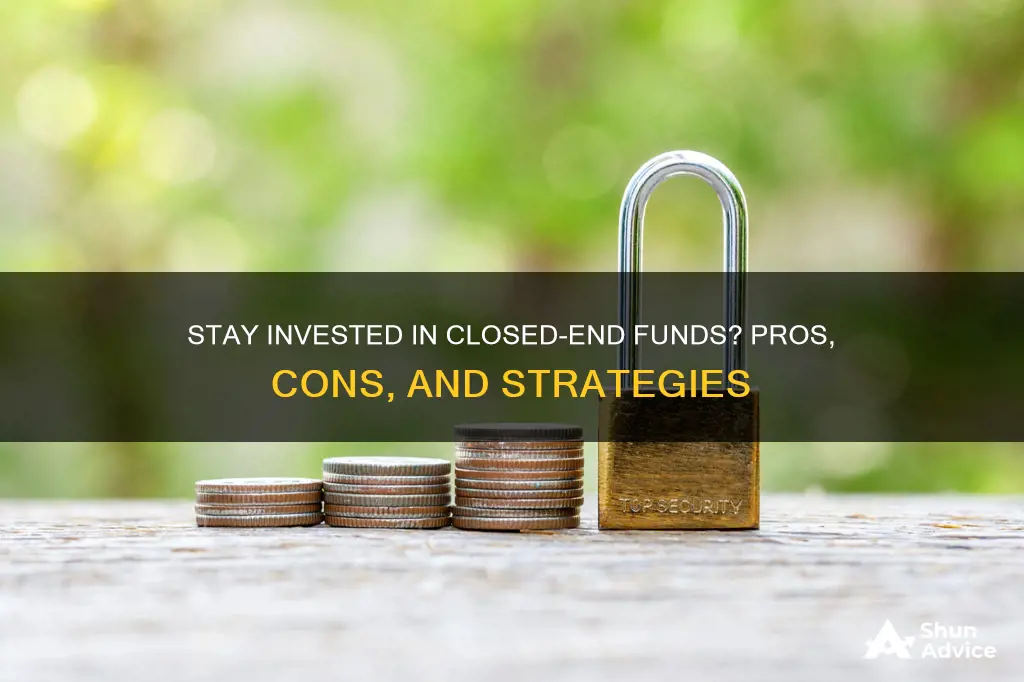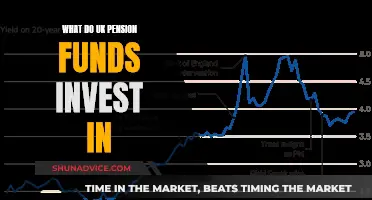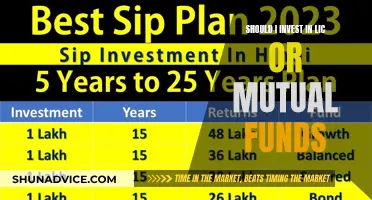
Closed-end funds are a type of mutual fund that issues a fixed number of shares through an initial public offering (IPO) to raise capital for its initial investments. Its shares can then be bought and sold on a stock exchange, but no new shares will be created, and no new money will flow into the fund. They are similar to mutual funds in that they professionally manage portfolios of stocks, bonds, or other investments (including illiquid securities). However, unlike mutual funds, closed-end funds tend to be less liquid and more volatile, and they can use leverage to boost their returns, which can increase gains and losses.
What You'll Learn

What are the risks of a closed fund?
There are several risks associated with closed-end funds. Firstly, they tend to be less liquid and more volatile than open-ended funds. This is because closed-end funds operate like exchange-traded funds (ETFs), with shares being bought and sold on the open market, and they have a fixed number of shares available. As a result, investors in closed-end funds may find themselves in the precarious position of having to purchase shares at a premium, which means paying more than the net asset value (NAV).
Secondly, closed-end funds have the ability to use leverage, which can lead to greater risk. They can borrow money to fund their asset purchases, and while this can increase returns in a rising market, it can also magnify losses when the market is falling. This use of leverage also means that closed-end funds tend to pay out higher dividends, which again can be a risk in a falling market.
Another risk to consider is that closed-end funds are often actively managed by investment managers who charge higher fees, making them less attractive to investors. Finally, closed-end funds can trade below their NAV for extended periods, which can be a risk for investors who buy at a premium and then see the share value drop.
Hedge Fund Investment Guide for Australians: Getting Started
You may want to see also

How does a closed fund compare to an open-end fund?
A closed-end fund is a type of mutual fund that issues a fixed number of shares through an initial public offering (IPO). Its shares can be bought and sold on a stock exchange, but no new shares will be created, and no new money will flow into the fund. A closed-end fund is launched through an IPO to raise money for investment. The fund manager takes charge of the IPO proceeds and invests the shares according to the fund's mandate.
On the other hand, an open-end fund, such as most mutual funds and exchange-traded funds (ETFs), accepts a constant flow of new investment capital. It issues new shares and buys back its own shares on demand. There is no limit to the number of available shares because the fund company can continue to create new shares as needed to meet investor demand.
Closed-end funds operate more like ETFs, in that they trade throughout the day on a stock exchange. They are also similar in that they are both actively managed. However, unlike ETFs, closed-end funds can use leverage, which can lead to greater risk but also greater rewards.
The pricing of open-end and closed-end funds also differs. Open-ended funds are priced once per day at the close of business, and every investor pays the same price, called the net asset value (NAV). Closed-end funds, like ETFs, also have an NAV, but the trading price may be higher or lower than that value, depending on supply and demand.
Another difference is that closed-end funds are less liquid and more volatile than open-ended funds. This is because closed-end funds are a somewhat complex investment vehicle, and few are followed by Wall Street firms or owned by institutions.
A Guide to Getting Started with Mutual Funds
You may want to see also

What are the tax implications of a closed fund?
When it comes to the tax implications of a closed-end fund, it's important to understand that the fund itself does not pay taxes. Instead, like open-end mutual funds and ETFs, closed-end funds pass the tax consequences of their investments on to their shareholders. This means that investors in closed-end funds will need to pay attention to the tax treatment of any distributions they receive.
There are a few potential sources of distributions from closed-end funds:
- Interest payments on fixed-income portfolio holdings
- Dividends from equity holdings
- Realized capital gains
- Pass-through (from master limited partnership investments, primarily)
- Constructive (from unrealized capital gains)
- Destructive (investors are receiving their own capital back, minus expenses)
The tax treatment of these different types of distributions can vary. For example, interest payments and dividends are generally taxed at a lower rate than capital gains. It's important for investors to understand the source of their distributions, as this will impact their tax obligations.
In the United States, closed-end funds are required to pass through to shareholders at least:
- 90% of net investment income from dividends and interest payments
- 98% of net realized capital gains
Additionally, investors should be aware that distributions from closed-end funds may include a return of capital, which means the fund is eroding its asset base to pay distributions. This can have different tax consequences than other types of distributions and may indicate that the fund is at a higher risk of future distribution reductions.
Overall, the tax implications of investing in a closed-end fund can be complex, and it's important for investors to consult with a tax professional to understand how distributions will impact their tax obligations.
Invest in Precious Metals Mutual Funds: A Beginner's Guide
You may want to see also

How does a closed fund's distribution rate differ from its total return?
A closed-end fund's distribution rate is its annualized income payout relative to its share price or net asset value (NAV). The total return, on the other hand, is the sum of the share price return and the distribution rate. The share price return is calculated by taking the share price at the end of a period and dividing it by the share price at the beginning of that period, then subtracting one.
The distribution rate is calculated in two ways: at the share price and at the net asset value. The former is the most relevant for shareholder returns, while the latter is more important for determining the sustainability of the distribution.
A closed-end fund's distribution rate can be as high as 7% or more, but it is not guaranteed. The fund's total return is more important than its distribution rate for long-term investors. This is because a high distribution rate can be accompanied by a declining share price return.
The share price and distributions are linked. Some funds distribute more money than their portfolios are generating by returning investors' capital. This is known as a destructive return of capital and will erode a fund's NAV over time.
Investing Money: Market Fund Strategies for Beginners
You may want to see also

What are the benefits of buying a closed fund at a discount?
Buying a closed fund at a discount can be an attractive feature for investors if it's understood. Here are some of the benefits of buying a closed fund at a discount:
- Yield enhancement: When a closed-end fund is purchased at a discount, investors will get a higher yield. For example, if a fund's underlying portfolio at NAV yields 10% and shares trade at a 10% absolute discount, investors will get an 11.1% distribution rate at the share price, enhancing their yield by 1.1%.
- Potential for capital appreciation: If the asset class of the fund has the potential for capital appreciation, and the fund board is unlikely to let a discount exist in perpetuity, investors can benefit from a higher income and potential for capital gains.
- Higher total returns: If the discount to the fund's net asset value (NAV) decreases and investors decide to sell their shares, they may benefit from higher total returns.
- Opportunities in volatile markets: In volatile markets, closed-end funds can trade at significant discounts, offering investors the opportunity to purchase shares well below their NAV.
- Tax advantages: Unlike open-end funds, CEF investors who don't sell their shares during a downturn won't incur any tax liability as the fund isn't forced to sell assets to meet redemption requests.
- No dilution of holdings: As closed-end funds have a fixed number of shares, new investors cannot dilute the holdings of current investors.
While buying a closed fund at a discount can provide benefits, it's important to carefully consider the reasons behind the discount and the fund's long-term prospects.
Equity Funds: Where to Invest and Why
You may want to see also
Frequently asked questions
A closed-end fund is a type of mutual fund that issues a fixed number of shares through an initial public offering (IPO) to raise capital for its initial investments. Its shares can then be bought and sold on a stock exchange, but no new shares will be created, and no new money will flow into the fund.
Closed-end funds can be appealing investment products because some offer distribution rates as high as 7% or more. They also tend to pay out higher dividends to investors. However, closed-end funds come with their own set of risks. They frequently use leverage (borrowed money) to increase returns, which can magnify losses when stocks are falling. They also tend to charge higher fees, making them less attractive to investors.
You can buy a closed fund through a brokerage account. When buying a closed fund, you'll want to consider the type of fund, its performance over time, its typical discount to net asset value and current discount, its expense ratio, the dividend it pays, and how much leverage it has taken on.
Many investors might feel more comfortable investing in an exchange-traded fund (ETF). ETFs trade throughout the day, like a closed-end fund, but they tend to track a market index such as the S&P 500, which means management fees are often lower.







